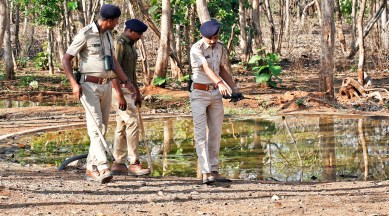Stay updated with the latest - Click here to follow us on Instagram
Delayed by pandemic, forest dept begins statewide leopard census
The Forest department conducts leopard census every five years. The last census was conducted in 2016 and the population of these large carnivores was estimated to be 1,395. That figure was second only to Madhya Pradesh.

Forest department employees and volunteers fanned out across the state, camping near waterholes to count leopards and other smaller carnivores, as the census for leopards began on Friday.
The census was due to be conducted in 2021 but was delayed due to Covid-19 pandemic.
monthly limit of free stories.
with an Express account.
The department has set up machans and built temporary huts near waterholes likely to be visited by leopards and other smaller carnivores like wolves, hyenas, caracals, ratels and foxes. The officials and volunteers would count the animals after directly sighting them while hiding in the huts or on machans at night or on the basis of fresh pug marks and scats or kills made by the carnivores.
“We will do a preliminary count from 5 pm on Friday to 9 am on Saturday. The final count will be taken between 5 pm on Saturday and 9 am on Sunday,” Nityanand Srivastava, Principal Chief Conservator of Forests (Wildlife) and Chief Wildlife Warden of Gujarat, said.
“We are using around 500 trap cameras in the census exercise,” he added.
Sanjay Srivastava, Additional Principal Chief Conservator of Forests (Administration) said that the census will cover the entire state and the forest department is taking help of local volunteers in respective districts for the exercise. “For the last three days, our staff had been monitoring movement of animals to identify census points. Teams will camp near identified places to count the animals,” he added.
He further said that 6,227 enumerators, including 1,331 volunteers will count leopards and other small carnivores at 4,086 census points.
The chief wildlife warden said that counting of carnivores near waterholes is an accepted method but the ongoing unseasonal rain is posing a challenge. “Carnivores can be found near waterholes during summer and therefore, the method of estimating their population by counting their numbers near waterholes is an accepted method. However, many parts of the state are experiencing unseasonal rain and posing a challenge to the exercise,” he added.
In Saurashtra, around 1,200 forest department staffers and volunteers have joined the leopard census exercise in lion landscape spread over Junagadh, Porbandar, Gir Somnath and Amreli districts. “In lion landscape, we conduct leopard census every year and the last year’s count was more than 520. But this time, we are counting the carnivores as part of the statewide exercise,” Aradhna Sahu, Chief Conservator of Forests of Junagadh Wildlife Circle, who is coordinating the census in the four districts, said.
The same teams would undertake census of herbivores from 7 am to 7 pm on Monday. They would count herbivores through line transact method and by counting heads to estimate the population of ungulates.
The Forest department conducts leopard census every five years. The last census was conducted in 2016 and the population of these large carnivores was estimated to be 1,395. That figure was second only to Madhya Pradesh.